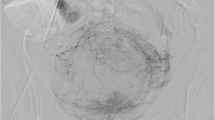Abstract
This is a report of a case of bladder ischemia which complicated bilateral prostatic artery embolization in an 80-year-old man with benign prostate hyperplasia and indwelling bladder catheter. Reflux of 100 μm microspheres into superior vesical arteries was the most likely cause. An unenhanced computed tomography (CT) scan performed immediately post-embolization showed retention of contrast in the left anterolateral bladder wall. Five days later, CT showed gas collections and dehiscence of the bladder wall at the same site, involving an area of 47 × 42 mm. Treatment included prolonged (6 weeks) bladder catheterization and antibiotics. Partial resolution of the CT findings and 43% reduction in the prostatic volume were noted after that period; no leakage was detected on ascending cystogram, and the patient was capable of spontaneous micturition.



Similar content being viewed by others
References
de Assis AM, Moreira AM, de Paula Rodrigues VC, Harward SH, Antunes AA, Srougi M, Carnevale FC. Pelvic arterial anatomy relevant to prostatic artery embolisation and proposal for angiographic classification. Cardiovasc Intervent Radiol. 2015;38(4):855–61.
Uflacker A, Haskal ZJ, Bilhim T, Patrie J, Huber T, Pisco JM. Meta-analysis of prostatic artery embolization for benign prostatic hyperplasia. J Vasc Interv Radiol. 2016;27(11):1686–97.
Carnevale FC, Moreira AM, Antunes AA. The “PErFecTED technique”: proximal embolization first, then embolize distal for benign prostatic hyperplasia. Cardiovasc Intervent Radiol. 2014;37(6):1602–5.
Yamaguchi O, Nomiya M, Andersson KE. Functional consequences of chronic bladder ischemia. Neurourol Urodyn. 2014;33(1):54–8.
Moreira AM, Marques CF, Antunes AA, Nahas CS, Nahas SC, de Gregorio Ariza MA, Carnevale FC. Transient ischemic rectitis as a potential complication after prostatic artery embolization: case report and review of the literature. Cardiovasc Intervent Radiol. 2013;36(6):1690–4.
Antunes AA, Carnevale FC, da Motta Leal Filho JM, Yoshinaga EM, Cerri LM, Baroni RH, Marcelino AS, Cerri GG, Srougi M. Clinical, laboratorial, and urodynamic findings of prostatic artery embolization for the treatment of urinary retention related to benign prostatic hyperplasia. A prospective single-center pilot study. Cardiovasc Intervent Radiol. 2013;36(4):978–86.
Gonçalves OM, Carnevale FC, Moreira AM, Antunes AA, Rodrigues VC, Srougi M. Comparative study using 100–300 versus 300–500 μm microspheres for symptomatic patients due to enlarged-BPH prostates. Cardiovasc Intervent Radiol. 2016;39(10):1372–8.
Bilhim T, Pisco J, Campos Pinheiro L, Rio Tinto H, Fernandes L, Pereira JA, Duarte M, Oliveira AG. Does polyvinyl alcohol particle size change the outcome of prostatic arterial embolization for benign prostatic hyperplasia? Results from a single-center randomized prospective study. J Vasc Interv Radiol. 2013;24(11):1595–602.
Ali A, Nabi G, Swami S, Somani B. Bladder necrosis secondary to internal iliac artery embolization following pelvic fracture. Urol Ann. 2014;6(2):166–8.
Marín-Sánchez P, Sánchez-Ferrer ML, Machado-Linde F. Conservative management of vesico-vaginal fistula after uterine and partial bladder necrosis due to embolization as a treatment for postpartum hemorrhage. Int Urogynecol J. 2015;26(5):773–4.
Author information
Authors and Affiliations
Corresponding author
Ethics declarations
Conflict of interest
Hippocrates Moschouris, Konstantinos Stamatiou, Ioannis Kornezos, Victoria Kartsouni and Katerina Malagari have no conflict of interest to disclose.
Ethical Approval
All procedures performed in studies involving human participants were in accordance with the ethical standards of the institutional and/or national research committee and with the 1964 Helsinki Declaration and its later amendments or comparable ethical standards.
Informed Consent
Informed consent was obtained from the patient included in the study.
Rights and permissions
About this article
Cite this article
Moschouris, H., Stamatiou, K., Kornezos, I. et al. Favorable Outcome of Conservative Management of Extensive Bladder Ischemia Complicating Prostatic Artery Embolization. Cardiovasc Intervent Radiol 41, 191–196 (2018). https://doi.org/10.1007/s00270-017-1774-2
Received:
Accepted:
Published:
Issue Date:
DOI: https://doi.org/10.1007/s00270-017-1774-2




